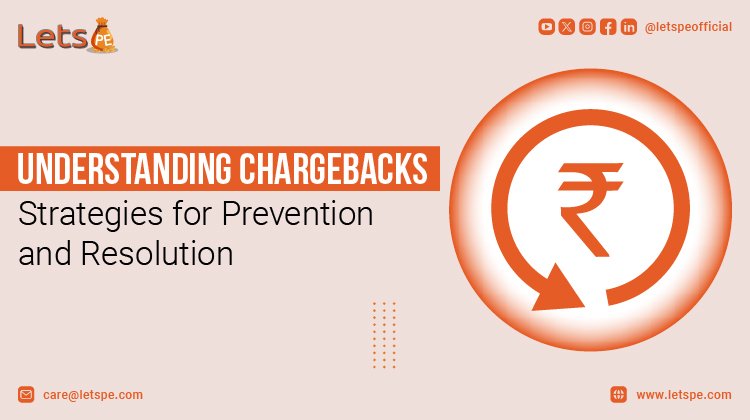Understanding Chargebacks: Strategies for Prevention and Resolution

Chargebacks are a costly problem for businesses. And it's a problem that is not going to go down in future. In retail, 51% of merchants claim chargeback rates are rising. Given the high costs connected with chargebacks, you must make some strategies to minimise the negative impact chargebacks have on our business. In this article, we explain more about how you can reduce chargebacks.
What's a chargeback?

A chargeback means money is returned directly to a customer’s account after they dispute a payment they've made via a card.
Chargebacks can be happen when
- A customer thinks a card payment was deceptive
- Services were not offered
- merchandise was not received
Can you reduce chargebacks?
It's unsolvable to wipe out chargebacks. But with an effective chargeback operation strategy, you can reduce the liability of chargebacks and disputes being and minimise their impact on your business.
Ten ways to reduce chargebacks
There are some ways you can take to keep disputes and chargebacks to a nominal.
Make your return, refund and cancellation programs clear
Easily communicate your return, refund and cancellation programs to customers at the time of the trade. This may help chargebacks for cancelled deals’, when the customer claims to have cancelled their order yet is still charged. Or for ‘sale not offered or ‘incorrect sale quantity’. Include your terms and conditions near the ‘Click to pay’ button, or as a separate crack box in the checkout process. Also include signs at point of sale, wording on bills or verbal prompts from deals staff are options for store-grounded businesses.
Confirm Customers Orders
It’s good business practice to confirm client orders. It may also help needless disputed payments too. However, manage the customer’s prospects, If you accept orders for goods or services to be delivered later. Update them on delivery times and allow them to track their order.
Let the customer know if products are out of stock, no longer available, or the delivery will be delayed. Offer the option of buying a choice or cancelling the order. This may help to reduce chargebacks for 'services not offered' or products not received' — two of the most common reasons for disputed payments.
Offer Good Customer Service
Assure that the contact details of your customer support department are easy to find on your website, published bills, delivery calendars and so on. Again, this is good business execution. But it may also help a routine inquiry from raising into a chargeback.
Train your customer service staff to resolve complaints instantly and completely in the first case to avoid indirect chargebacks later. Keep your procedures for client billing queries and claims under constant review.
Use a clear billing descriptor on customer statements
Check that the billing descriptor on statements can be fluently understood by the client. Best execution is they should be suitable to identify the purchase instantly so they don’t mistakenly initiate a dispute. Still, choose the bone that’s likely to be most close to guests, If the registered name of your business is different from your merchandise name. Also, settling the ‘megacity’ field with the city or post/zip code of the store, or your website address for online orders, can help run a client's memory.
Delay Billing
To help ‘non-receipt of goods’ disputes, don’t charge cards until goods have been shipped. However, it may get confused and lead to a preventable disagreement, If customers see deals on their statements before goods arrive. Just as it’s best not to submit deals too early, don’t submit them too late, moreover. This helps minimise ‘late fair’ or ‘credit not reused’ disputes.
Gain evidence of customer participation
Presenting exciting evidence that the client shared in the sale and/or entered the products helps defend certain chargebacks. Configure your internal processes to capture the customer’s account order history, easily showing all deals. Collect and retain signed delivery bills from the customer, courier shadowing attestation, or the client’s IP address, description, date and time of download, if you sell digital services.
Influence strong client Authentication rules
Identify and confirm client individualities using 3D Secure 2.0
(3DS2). This streamlined protocol offers a subcaste of protection against the deceptive use of accounts — one of the most common reasons for chargebacks in the card not-present space. Payment providers now assure payment for certain successful online deals that have been authenticated with 3D Secure 2.0 (3DS2). More importantly, 3DS2 is an occasion to partake more data and help issuers with threat-grounded authentication to give better customer service at the checkout.
Also Read - Why are Digital Payments Better than Cash?
Cancel recreating deals instantly
As a best execution, cancel recreating deals instantly. Confirm the cancellation to the client in writing, stating the effective date of the cancellation. Remind them of any cancellation restrictions in cases where the client has paid over-frontal for a subscription or class of a pre-agreed duration. Offer to take another form of payment for the remainder of their subscription or class, as applicable.
Update Expired Cards
There’s no need to avoid chargebacks, lose deals or miss payments because your customer's card has expired. Mastercard and Visa refresh details if cards expire, are lost, stolen or upgraded.
Draw on the support of your payment provider
Innovative businesses and their PSPs use payment data prophetically to describe and help fraud. But to see results, you need access to the right type of data and capabilities. You need a fraud discovery tool with a Machine Learning point trained on billions of hard and soft data points from a global network of merchants. It can also learn from patterns of real fraud across multiple sectors and channels. These perceptivity can also be applied to identify and stop suspicious exertion at the point of trade. You can also be less exposed to being and issuing fraud patterns, with wider perceptivity and literal data about being and arising fraud patterns.












